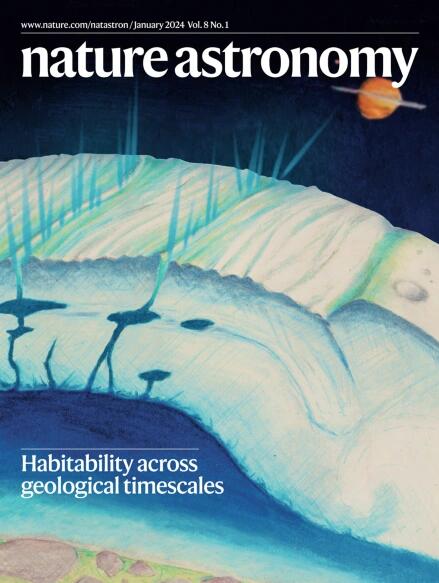费米探测的伽马射线发射热日冕的无线电安静的活动星系核
IF 14.3
1区 物理与天体物理
Q1 ASTRONOMY & ASTROPHYSICS
引用次数: 0
摘要
超大质量黑洞周围的相对论性喷流是众所周知的强大γ射线发射体。尽管在过去的三十年里进行了大量的观测工作,但在没有射电安静的活动星系核中没有喷流的情况下,超大质量黑洞是如何在γ射线带中工作的仍然是未知的。在这里,考虑到之前的努力,我们仔细选择了一个由37个附近的Seyfert星系组成的活动星系核样本,用超硬x射线进行γ射线检测,排除了该波段的所有潜在污染。采用堆叠技术,我们报告了15年Fermi-LAT观测样本的显著γ射线检测(检验统计量30.6或5.2σ)。我们发现样品的γ射线平均光度为(1.5±1.0)× 1040 erg s−1,能量为1 - 300 GeV。受γ射线与低能光子相互作用产生的众所周知的对的限制,发现超过几千兆电子伏特的γ射线起源于扩展的日冕(~2.7 × 106引力半径),而典型的更致密的x射线日冕(~10引力半径)负责一到几千兆电子伏特的γ射线。紧凑区域的发现为长期的理论期望提供了强有力的支持,但扩展的日冕是一个意想不到的发现。一个有希望的设想是,在致密x射线日冕中产生的电子-正电子对会像火球一样膨胀,类似于γ射线爆发,形成扩展日冕的结构。本文章由计算机程序翻译,如有差异,请以英文原文为准。


Fermi detection of gamma-ray emission from the hot coronae of radio-quiet active galactic nuclei
Relativistic jets around supermassive black holes are well-known powerful γ-ray emitters. In the absence of the jets in radio-quiet active galactic nuclei, how the supermassive black holes work in γ-ray bands is still unknown despite great observational efforts in the past three decades. Here, considering the previous efforts, we carefully select an active galactic nucleus sample composed of 37 nearby Seyfert galaxies with ultrahard X-rays for γ-ray detection by excluding all potential contamination in this band. Adopting a stacking technique, we report the significant γ-ray detection (test statistic 30.6, or 5.2σ) from the sample using 15-year Fermi-LAT observations. We find the average γ-ray luminosity of the sample to be (1.5 ± 1.0) × 1040 erg s−1 at energies of 1–300 GeV. Limited by the well-known pair production from the interaction of γ-rays with low-energy photons, γ-rays of more than several giga-electronvolts are found to originate from an extended corona (~2.7 × 106 gravitational radii), whereas the canonical much more compact X-ray corona (~10 gravitational radii) is responsible for γ-rays of one to several giga-electronvolts. The finding of the compact region lends strong support to the long-time theoretical expectations, but the extended corona is an unexpected finding. One promising scenario is that the electron–positron pairs produced in the compact X-ray corona would expand as a fireball, similar to that in γ-ray bursts, forming the structure of extended corona. The Fermi-LAT Collaboration reports a significant γ-ray detection (5.2σ) from the coronae of radio-quiet active galactic nuclei, revealing compact (~10 gravitational radii) and extended (~2.7 × 106 gravitational radii) corona regions, challenging existing models.
求助全文
通过发布文献求助,成功后即可免费获取论文全文。
去求助
来源期刊

Nature Astronomy
Physics and Astronomy-Astronomy and Astrophysics
CiteScore
19.50
自引率
2.80%
发文量
252
期刊介绍:
Nature Astronomy, the oldest science, has played a significant role in the history of Nature. Throughout the years, pioneering discoveries such as the first quasar, exoplanet, and understanding of spiral nebulae have been reported in the journal. With the introduction of Nature Astronomy, the field now receives expanded coverage, welcoming research in astronomy, astrophysics, and planetary science. The primary objective is to encourage closer collaboration among researchers in these related areas.
Similar to other journals under the Nature brand, Nature Astronomy boasts a devoted team of professional editors, ensuring fairness and rigorous peer-review processes. The journal maintains high standards in copy-editing and production, ensuring timely publication and editorial independence.
In addition to original research, Nature Astronomy publishes a wide range of content, including Comments, Reviews, News and Views, Features, and Correspondence. This diverse collection covers various disciplines within astronomy and includes contributions from a diverse range of voices.
 求助内容:
求助内容: 应助结果提醒方式:
应助结果提醒方式:


